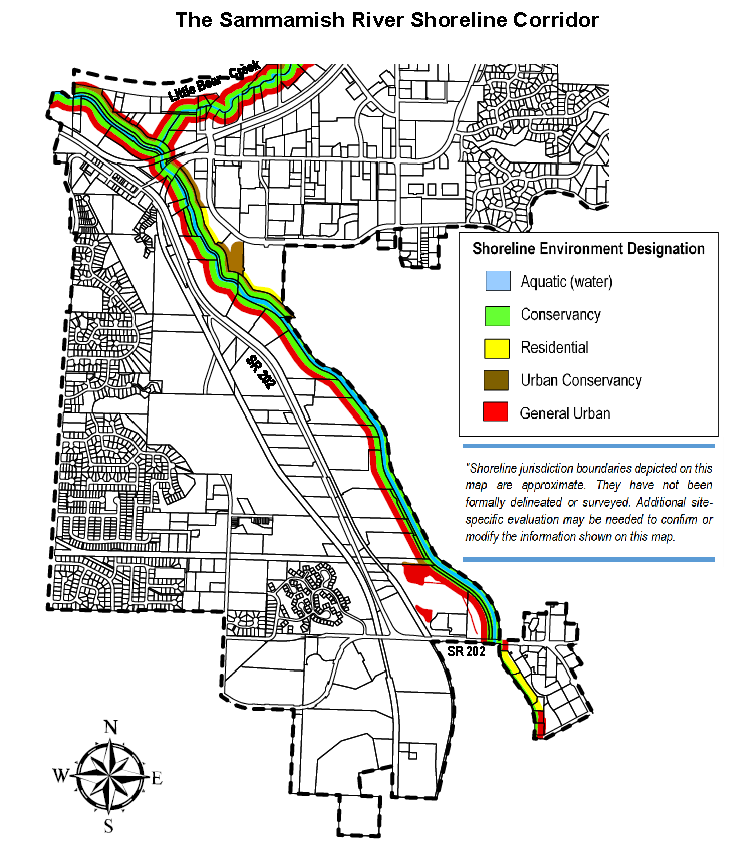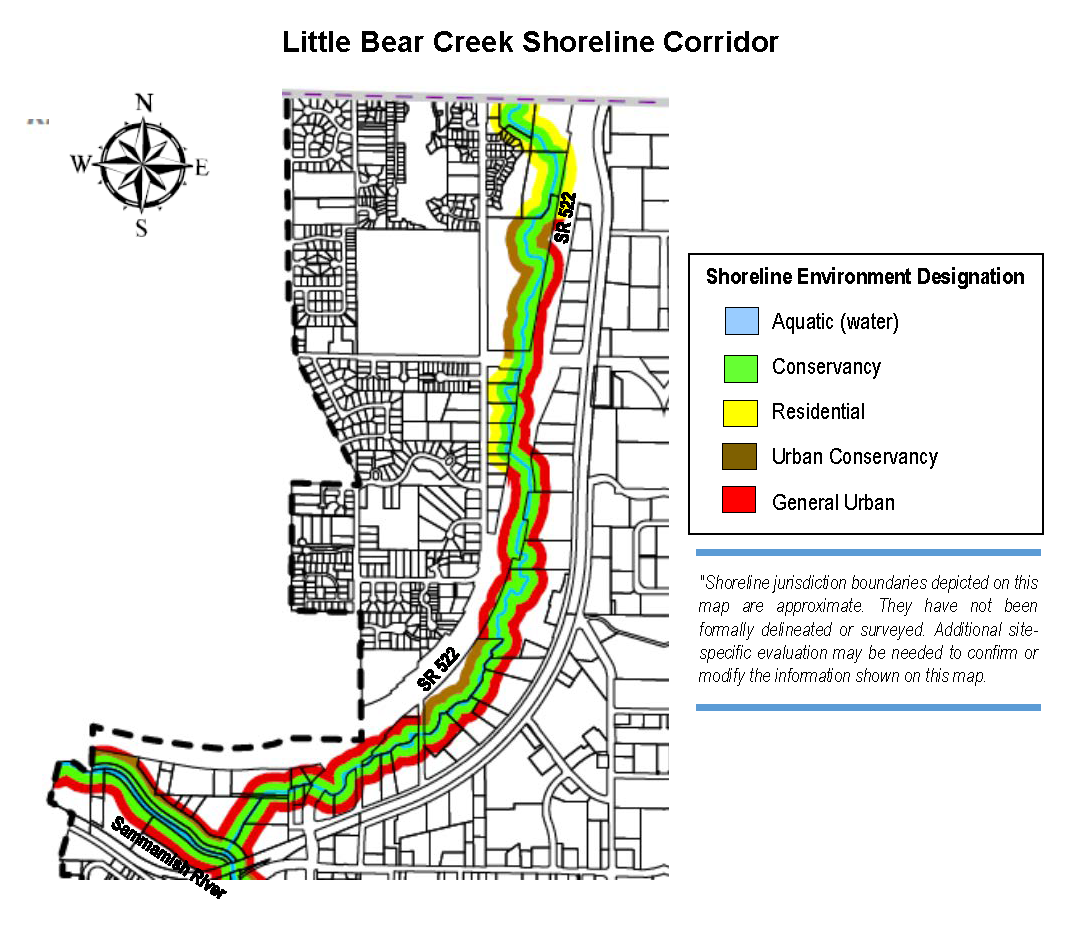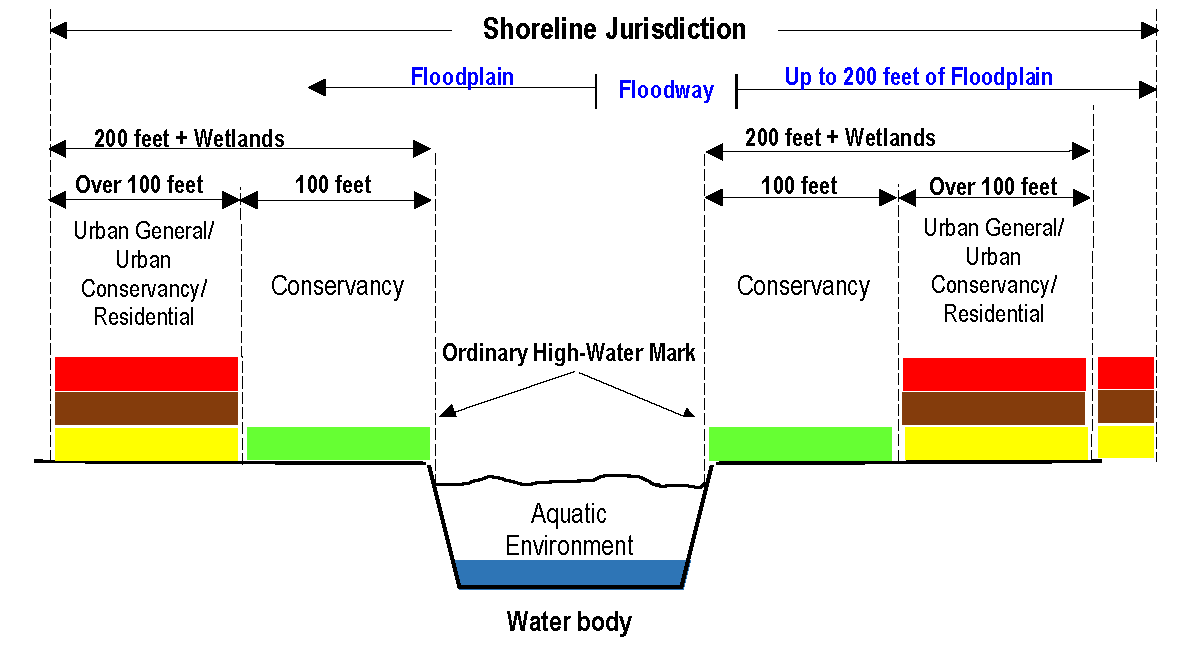Chapter 21.71
SHORELINE ENVIRONMENT DESIGNATIONS
Sections:
21.71.020 Establishment of shoreline environment designations.
21.71.030 Shoreline jurisdiction and shoreline map.
21.71.040 Aquatic Environment.
21.71.050 Conservancy Environment.
21.71.060 Shoreline Residential Environment.
21.71.080 Urban General Environment.
21.71.010 Findings.
The City’s shorelines comprise a riverine system centered on the Sammamish River, which flows north and west through the City, and Little Bear Creek, a major tributary, which flows southwest through the western portion of downtown. Existing uses along the shorelines are comprised of residential, public, private recreation and dedicated open space, commercial and industrial uses. (Ord. 716 § 4 (Att. A), 2021)
21.71.020 Establishment of shoreline environment designations.
Woodinville’s shoreline is divided into the following shoreline environment designations based upon the designation criteria prescribed by this chapter:
(1) Aquatic;
(2) Conservancy;
(3) Shoreline Residential;
(4) Urban Conservancy; and
(5) Urban General. (Ord. 716 § 4 (Att. A), 2021)
21.71.030 Shoreline jurisdiction and shoreline map.
The Shoreline Environment Designation Map set forth in Figure 21.71.030(1) and the Shoreline Environmental Zone Diagram in Figure 21.71.030(2) are graphic representations of the City’s shoreline jurisdiction regulated by the shoreline master program. Figure 21.71.030(1) serves as the official map for assigning shoreline environment designations to properties subject to the following interpretations:
(1) The boundaries depicted on the map are approximate and are for planning purposes only;
(2) The precise extent of shoreline jurisdiction is determined at the time of a development proposal using additional site-specific evaluation to confirm and/or verify actual boundaries of the shoreline jurisdiction;
(3) Property lines and the designation criteria in this chapter shall be used for interpreting the boundaries of shoreline environment designation, except:
(a) For the aquatic environment, the ordinary high water mark is used for interpreting the boundary; and
(b) Where more than one shoreline environment is shown within a public right-of-way, excluding the State right-of-way, the centerline of the right-of-way is used for interpreting the boundary; and
(c) All areas not mapped or designated are automatically assigned an Urban Conservancy Environment designation until the shoreline can be redesignated through a master program amendment.
Figure 21.71.030(1) – Shoreline Environment Designation Map

Figure 21.71.030(2) – Shoreline Environmental Zone Diagram
(Ord. 716 § 4 (Att. A), 2021)
21.71.040 Aquatic Environment.
(1) Purpose. The purpose of the Aquatic Environment is to protect, restore, and manage the unique characteristics and resources of the areas waterward of the ordinary high water mark.
(2) Designation Criteria. Assign an Aquatic Environment designation to lands waterward of the ordinary high water mark.
(3) Management Policies. The following policies apply to all Aquatic Environment areas:
(a) Allow new over-water structures only for water-dependent uses, public access, scientific research, or ecological restoration;
(b) The size of new over-water structures should be limited to the minimum necessary to support the intended use;
(c) Encourage multiple use of over-water facilities to reduce impacts from shoreline development and increase effective use of water resources;
(d) All developments and uses on navigable waters or their beds should be located and designed to minimize interference with surface navigation, to consider impacts to public views, and to allow for the safe, unobstructed passage of fish and wildlife, particularly those species dependent on migration;
(e) Uses that adversely impact the ecological functions of critical freshwater habitats should not be allowed except where necessary to achieve the objectives of RCW 90.58.020, and then only when their impacts are mitigated according to the sequence described in WAC 173-26-201(2)(e) as necessary to assure no net loss of ecological functions; and
(f) Shoreline uses and modifications should be designed and managed to prevent degradation of water quality and alteration of natural hydrographic conditions. (Ord. 716 § 4 (Att. A), 2021)
21.71.050 Conservancy Environment.
(1) Purpose. The purpose of the Conservancy Environment is to protect and restore ecological functions while making areas available for limited human use, when appropriate and nondestructive of critical areas. The Conservancy Environment is intended to balance the existing development within the shoreline jurisdiction to be consistent with the shoreline critical area regulations.
(2) Designation Criteria. Assign a Conservancy Environment designation to all shorelands extending 100 feet landward from the ordinary high water mark.
(3) Management Policies. The following policies apply to all Conservancy Environment areas:
(a) Critical areas can be altered only as a last resort and only when overriding State-wide interests or protection or enhancement of the natural resources require the alteration;
(b) Uses should be compatible with uses and activities in adjacent environments and should meet the Shoreline Management Act guideline (WAC 173-26-211(2)(a)) of being nonconsumptive of the physical and biological resources of the area;
(c) Preservation of resources must have priority over public access recreation and development objectives whenever a conflict exists; and
(d) Construction of structural shoreline stabilization and flood control works should be minimized. (Ord. 716 § 4 (Att. A), 2021)
21.71.060 Shoreline Residential Environment.
(1) Purpose. The purpose of the Shoreline Residential Environment is to accommodate residential development and appurtenant structures that are consistent with the Shoreline Management Act. An additional purpose is to provide appropriate public access and recreational uses.
(2) Designation Criteria. Assign a Shoreline Residential Environment designation to all shorelands extending beyond the first 100 feet landward from the ordinary high water mark that are predominantly characterized by single-family or multifamily residential development or are planned for residential development.
(3) Management Policies. The following policies apply to all Shoreline Residential Environment areas:
(a) Development standards shall be set to maintain no net loss of shoreline ecological functions;
(b) Proposed projects should be reviewed for consistency with the no net loss policy, considering (i) the environmental limitations and sensitivity of the shoreline area, (ii) proposed mitigation for anticipated impacts, (iii) the level of infrastructure and services available, and (iv) other comprehensive planning considerations;
(c) Multifamily and multi-lot residential and recreational developments should provide public access and joint-use recreational facilities where appropriate; and
(d) Access, utilities, and public services should be available and adequate to serve existing needs and/or planned future development. (Ord. 716 § 4 (Att. A), 2021)
21.71.070 Urban Conservancy.
(1) Purpose. The purpose of the Urban Conservancy Environment is to protect and restore ecological functions of open space, floodplain and other sensitive lands where they exist in urban and developed settings, while allowing a variety of compatible uses.
(2) Designation Criteria. Assign an Urban Conservancy Environment designation to all shorelands extending beyond the first 100 feet landward from the ordinary high water mark that are planned for development compatible with maintaining or restoring ecological functions of the area, and that are not generally suitable for water-dependent uses, or lie in areas where any of the following characteristics apply:
(a) They are open space, floodplain or other sensitive areas that should not be more intensively developed;
(b) They have potential for ecological restoration;
(c) They retain important ecological functions, even though partially developed; or
(d) They have the potential for development that is compatible with ecological restoration.
(3) Management Policies. The following policies apply to all Urban Conservancy Environment areas:
(a) Uses that preserve the natural character of the area or promote preservation of open space, floodplain or sensitive lands either directly or over the long term should be the primary allowed uses. Uses that result in restoration of ecological functions should be allowed if the use is otherwise compatible with the purpose of the environment and the setting;
(b) Standards should be established for shoreline stabilization measures, vegetation conservation, water quality, and shoreline modifications within the Urban Conservancy designation; and these standards, in combination with proposed mitigation for any anticipated impacts, should ensure that new development does not result in a net loss of shoreline ecological functions or further degrade other shoreline values;
(c) Public access and public recreation objectives should be implemented whenever feasible and significant ecological impacts can be mitigated; and
(d) Water-oriented uses should be given priority over non-water-oriented uses. For shoreline areas with commercial development or adjacent to commercially navigable waters, water-dependent uses should be given highest priority. (Ord. 716 § 4 (Att. A), 2021)
21.71.080 Urban General Environment.
(1) Purpose. The purpose of the Urban General Environment is to provide for economically viable use of commercial and industrial areas that contain existing non-water-dependent use or are not suitable for water-dependent uses due to limited or no water access, and to protect existing ecological functions.
(2) Designation Criteria. Assign an Urban General Environment designation to all shorelands extending beyond the first 100 feet landward from the ordinary high water mark that are zoned industrial, commercial, or mixed-use and contain existing non-water-dependent industrial and commercial uses.
(3) Management Policies. The following policies apply to all Urban General Environment:
(a) Non-water-dependent uses should not replace existing water-dependent uses;
(b) Development standards shall be set to maintain no net loss of shoreline ecological functions;
(c) Proposed projects should be reviewed for consistency with the no net loss policy, considering (i) the environmental limitations and sensitivity of the shoreline area, (ii) proposed mitigation for anticipated impacts, (iii) the level of infrastructure and services available, and (iv) other comprehensive planning considerations; and
(d) Industrial and commercial development should provide public access to the shoreline where appropriate. (Ord. 716 § 4 (Att. A), 2021)


